In this post, you’ll learn what are belt drives and how they work.
Different types of belt drives, What is a slip and creep in the belt, and advantages & disadvantages of belt drives.
What is Belt Drive?
The rotation motion is the ideal and the simplest means of transmission of mechanical power with negligible losses.
These systems are driven by a prime mover or transmit the rotational motion to the various parts of a machine within itself. Usually, shafts are employed to transmit rotational motion.
- The one that drives is called the driving system and
- The other which is driven is called the driven system.
Functions of Belt Drive
Belt drives are a type of frictional drive used for transmitting powers from one shaft to another using pulleys that rotate at the same speed or a different speed.
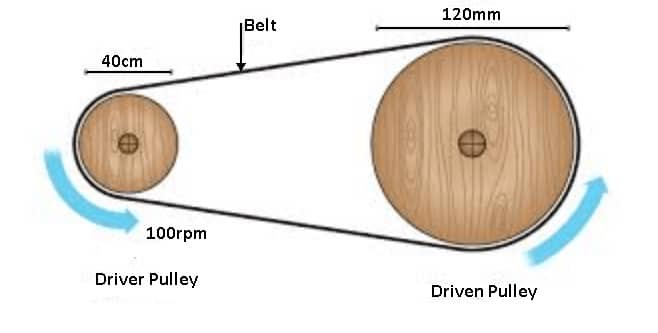
A belt drive is shown in the figure. It consists of two pulleys over which an endless belt passes over them. The mechanical power or rotary motion is transmitted from the driving pulley to the driven pulley because of the frictional grip that exists between the belt and the pulley surface.
The portion of the belt which is having less tension is called the slack side and the one which has higher tension is called the tight side. The effective pulling power of the belt that causes the rotation of the driven pulley is the difference in tension on the slack and tight sides.
The tensions in the tight and slack sides of the belt depend on the angle of contact, the belt drives have to be arranged such that the slack side comes above and the tight side comes below the pulleys.
This arrangement increases the angled contact of the belt on the driven side. Sometimes in a belt drive, there is always a possibility of some slipping taking place between the belt and the pulleys which causes the driven pulley to rotate at a lesser speed, consequently reducing the power transmission. Hence belt drives are said to be not a Positive type of power transmission system
Types of Belts
There are four commonly used types of belts:
- Flat belt
- V belt
- Circular
#1 Flat Belt
This belt has a rectangular cross-section. These belts are capable of transmitting power over long distances between pulley centers. The efficiency of this drive is around 98% and produces little noise.

#2 V-belts
V-belts also used with grooved pulleys, V-belts are trapezoidal in cross-section. These belts permit a large speed ratio and can transmit higher power. Multiple drives are possible.
#3 Circular
This type of belt has a circular cross-section and is used with grooved pulleys.
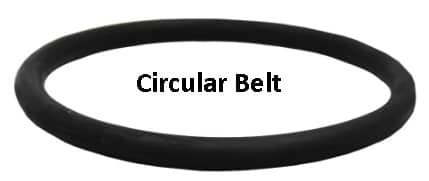
Types of Belt Drives
The following are the 5 main types of Belt Drives:
Open Belt Drive
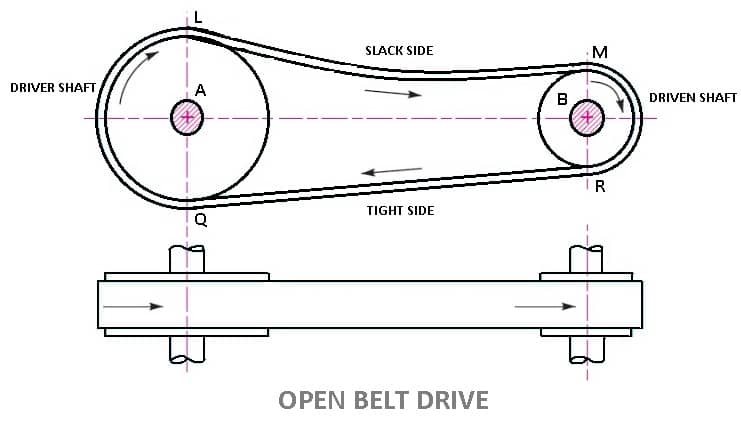
- In
these types of belt drive, the belt is employed when the two parallel shafts have to rotate in the same direction. - When the shafts are far apart, the lower side of the belt should be the tight side and the upper side must be the slack side.
- This is because, when the upper side becomes the slack side, it will sag due to its own weight and thus increase the arc of contact.
Cross Belt Drive
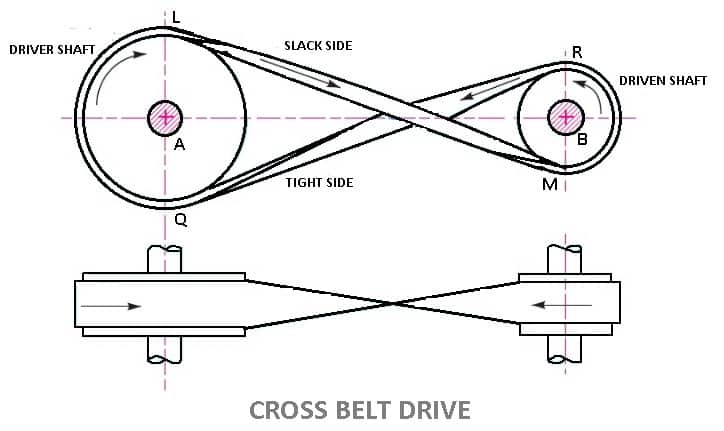
- In this type of belt drive, the belt is employed when two parallel shafts have to rotate in the opposite direction. At the junction where the belts cross, it rubs against itself and wears off.
- To avoid excessive wear, the shafts must be placed at a maximum distance from each other and operated at very low speeds.
Stepped Cone Pulley or Speed Cone Drive
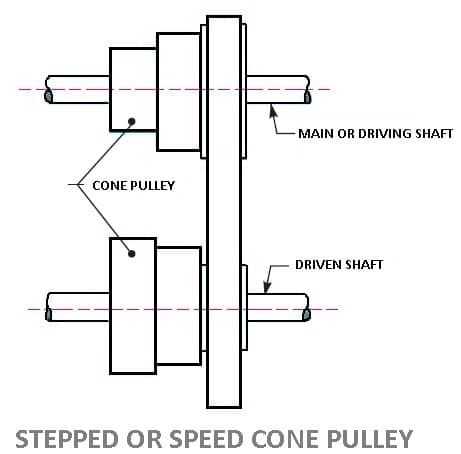
- These types of belt drives are used when the speed of the driven shaft is to be changed very frequently as in the case of machine tools such as lathes, drilling machines, etc.
- A stepped cone pulley is an integral casting having three or many pulleys of different sizes one adjacent to the other as shown in Fig.
- One set of stepped cone pulley is mounted in reverse on the driven shaft. An endless belt will be wrapped around one pair of pulleys.
- By shifting the belt from one pair of pulleys to the other, the speed of the driven shaft can be varied.
- The diameter of the driving and driven pulleys is such that the same belt will operate when shifted on different pairs of pulleys.
Fast and Loose Pulley Drive
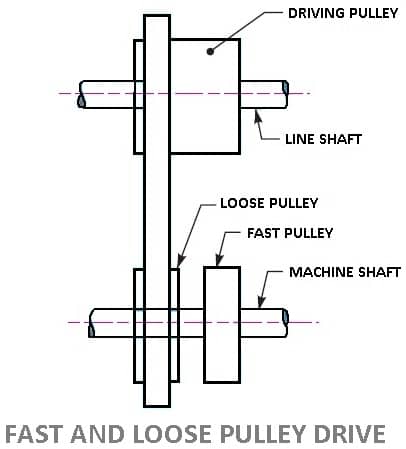
- This types of belt drive are used when the driven or machine shaft is to be started or stopped whenever desired without interfering with the driving shaft.
- A pulley that is keyed to the machine shaft is called a fast pulley and runs at the same speed as that of the machine shaft.
- A loose pulley runs freely over the machine shaft and is incapable of transmitting any power.
- When the driven shaft is required to be stopped, the belt is pushed onto the loose pulley using a sliding bar having belt forks.
Jockey Pulley Drive
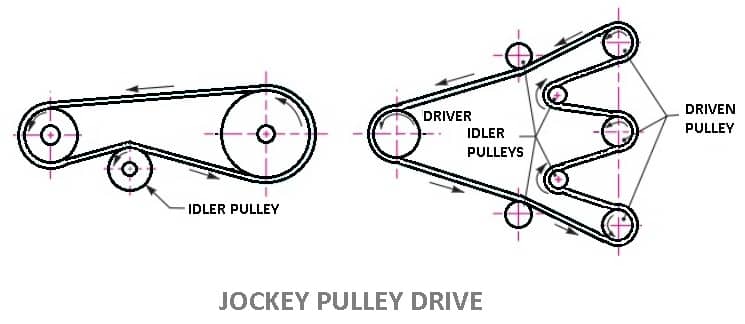
- In an open belt drive arrangement, if the center distance is small, or if the driven pulleys are very small, then the arc of contact of the belt with the driven pulley will be very small, which reduces the tensions in the belt, or if the required tension of the belt cannot be obtained by other means, an idler pulley, called jockey pulley is placed on the slack side of the belt as shown in fig.
- Which increases the arc of contact and thus the tension which results in increased power transmission.
Slip And Creep In Belt Drive
Slip in Belts
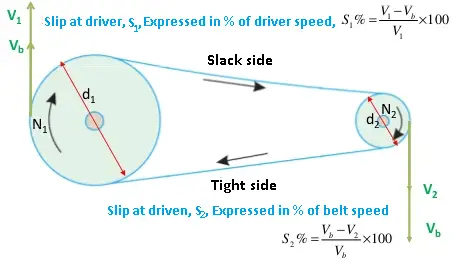
Consider an open belt drive rotating in a clockwise direction, this rotating of the belt over the pulleys is assumed to be due to a firm frictional grip between the belt and the pulleys.
When this frictional grip becomes insufficient, there is a possibility of forwarding motion of the driver without a pulley with it, this is known as the slip in a belt.
Therefore slip may be defined as the relative motion between the pulley and the belt in it. This reduces the velocity ratio and is usually expressed in % and it is denoted by S.
Creep in Belts
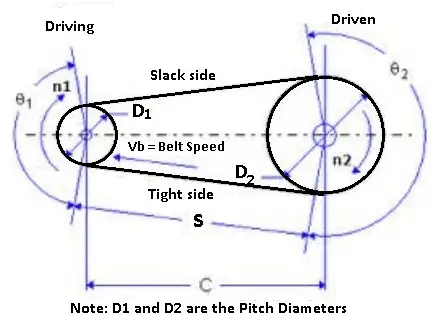
Consider an open belt drive rotating in the clockwise direction. The portion of the belt leaving the driver and entering the driver is known as the tight side and a portion of the belt leaving the driver and entering the is known as the slack side.
During rotation, a belt is expanded on the tight side and a contraction of the belt on the slack side.
Due to this uneven expansion and contraction of the belt over the pulleys, there will be a relative movement (motion) of the belt over the pulleys this phenomenon is known as Creep in a belt.
Advantages and Disadvantages of Flat Belts
The following are the advantages and disadvantages of belt drive.
Advantages
- Flexible, simple in construction, smooth operations.
- Efficient at high speeds and protects against overload.
- Running and maintenance costs are low.
- Relatively long life and is easy to work with.
Disadvantages
- Loss of power due to slip and creep in turn results in low efficiency.
- Not preferred for
short-center distances. - because of the endlessness of the belt, joints reduce the life of the belt.
- Not a positive drive.
Materials Used For Belts
The materials used for belts must be strong, flexible, and durable. It should have a high coefficient of friction. The various materials used are:
- Leather
- Fabric
- Rubber
- Balata
Leather: The leather may be oak-tanned mineral salt-tanned ex: Chrome-tanned. When the thickness of the belt required is more than, two or more strips are cemented together. Leather belts require periodic cleaning.
Fabric: Fabric belts are made by folding canvas or cotton ducks in a layer (depending on the required thickness) and stitching together.
Rubber: The belts are made of Fabric with a rubber layer. These are used in sawmills, paper mills, etc.
Balata: The belts are made out of these materials similar to rubber belts except that balata gym is used instead of rubber. The belts of these materials are acid and waterproof but cannot be used where the temperature is above 45°.
V-Belts
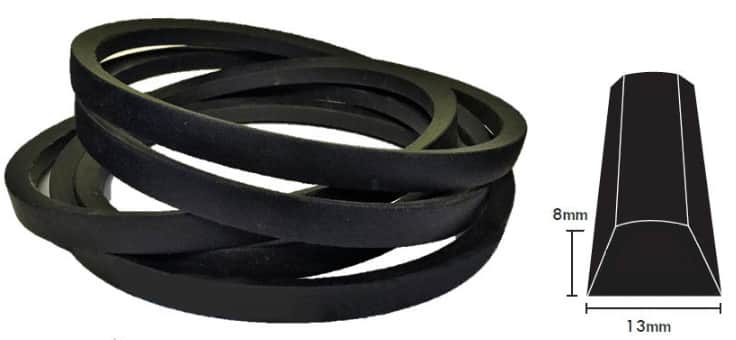
The V-belts or “V” types of belt drives are widely used in high-power transmission. V-belts are trapezoidal in section as shown in the figure. They are molded as endless loops from rubber reinforced with fibrous material. They run in the v-grooves made in the pulleys.
The wedging action of the belts in the V-grooves enables them to transmit higher torques. The power transmitted by a V-belt drive can be increased by operating with several belts.
This form of drive is used extensively in all classes of
Advantages and Disadvantages of The V-belt Drive Over A Flat Belt Drive
Following are the advantages and disadvantages of the v-belt drive over the flat belt drive.
- The v-belt drive gives compactness due to the small distance between the centers of pulleys.
- The drive is positive because the slip between the belt and the pulley groove is negligible.
- Since the v-belt is made endless and there is no trouble, therefore the drive is smooth.
- It provides a longer life, 3 to 5 years.
- The operation of the belt and pulley is quiet.
- It can be easily installed and removed.
- The belt can cushion the shock when machines are started.
- The high-velocity ratio (maximum 10) may be obtained.
- V-belt may be operated in either direction with the tight side of the belt at the top or bottom.
- Therefore the power transmitted by v-belts is more than flat belts.
- The center line may be horizontal, vertical, or inclined.
Selection of Belt Drive
The following factors are considered in the selection of belt drives.
- The speed of the driver and driven pulleys
- Speed reduction ratio
- Power to be transmitted
- Center distance between the shaft
- Shaft layout
- Positive drive requirements
That is it, Thanks for reading. If you like our article on belt drives and types of belt drives share this with your friends. If you have any questions leave a comment I’ll respond.
Subscribe to our newsletter.
Download PDF file of this article:
Read Next:

best information place , Thank very much
You’re welcome.
Thank you the lecture note
You’re welcome.
Thanks for sharing this article, Its very helpful to understand different types of drives.
You’re welcome.
thank you for the information
You’re welcome.
Best information place
Thanks for your feedback.
Best information
Thanks
Good information 😊😊
Thank you so much 🙂
When will this article be finished ?
* continuous belt v ‘link’ belts
* ‘rubber’ v metal belts (Vehicle CVT)
* toothed flat belts – square teeth, rounded teeth – giving positive transmission
* multi-V belts / flat belts with several ‘micro v’ grooves
* etc. (get-out clause for any others I’ve not mentioned 😉 )
I’ve even seen metal round belts (like continuous coil spring) with mating grooves in the pulleys – so gives, on average, positive transmission
Great👍 Thanks for the comment, we will update this article in future as you mentioned 🙂
very good note
Thanks 🙂